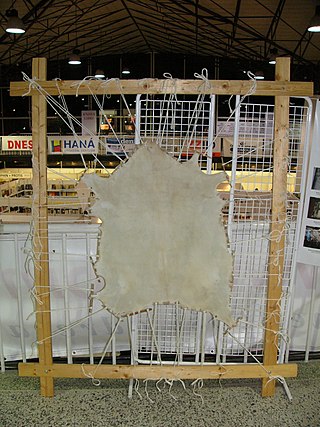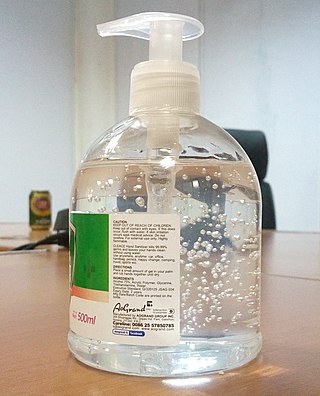
The drum is a member of the percussion group of musical instruments. In the Hornbostel-Sachs classification system, it is a membranophone. Drums consist of at least one membrane, called a drumhead or drum skin, that is stretched over a shell and struck, either directly with the player's hands, or with a percussion mallet, to produce sound. There is usually a resonant head on the underside of the drum. Other techniques have been used to cause drums to make sound, such as the thumb roll. Drums are the world's oldest and most ubiquitous musical instruments, and the basic design has remained virtually unchanged for thousands of years.

Kalmia latifolia, the mountain laurel, calico-bush, or spoonwood, is a species of flowering plant in the heath family Ericaceae, that is native to the eastern United States. Its range stretches from southern Maine south to northern Florida, and west to Indiana and Louisiana. Mountain laurel is the state flower of Connecticut and Pennsylvania. It is the namesake of Laurel County in Kentucky, the city of Laurel, Mississippi, and the Laurel Highlands in southwestern Pennsylvania.

Parchment is a writing material made from specially prepared untanned skins of animals—primarily sheep, calves, and goats. It has been used as a writing medium for over two millennia. Vellum is a finer quality parchment made from the skins of young animals such as lambs and young calves.

Sir Roderick David Stewart is a British rock and pop singer and songwriter. Born and raised in London, he is of Scottish and English ancestry. With his distinctive raspy singing voice, Stewart is among the best-selling music artists of all time, having sold more than 120 million records worldwide. He has had 10 number-one albums and 31 top-ten singles in the UK, six of which reached number one. Stewart has had 16 top-ten singles in the US, with four reaching number one on the Billboard Hot 100. He was knighted in the 2016 Birthday Honours for services to music and charity.
A membranophone is any musical instrument which produces sound primarily by way of a vibrating stretched membrane. It is one of the four main divisions of instruments in the original Hornbostel-Sachs scheme of musical instrument classification.

The shamisen, also known as sangen or samisen (all meaning "three strings"), is a three-stringed traditional Japanese musical instrument derived from the Chinese instrument sanxian. It is played with a plectrum called a bachi.

Dhol can refer to any one of a number of similar types of double-headed drum widely used, with regional variations, throughout the Indian subcontinent. Its range of distribution in Indian subcontinent primarily includes northern areas such as the Jammu, Himachal, Punjab, Haryana, Delhi, Kashmir, Sindh, Assam Valley, Uttarakhand, West Bengal, Odisha, Gujarat, Maharashtra, Konkan, Goa, Karnataka, Rajasthan, Bihar, Jharkhand and Uttar Pradesh. A related instrument is the dholak or dholki. Dhols are amongst other events used in Indian wedding ceremony processions such as Baraat or Varyatra.

In biology, moulting, or molting, also known as sloughing, shedding, or in many invertebrates, ecdysis, is a process by which an animal casts off parts of its body to serve some beneficial purpose, either at specific times of the year, or at specific points in its life cycle.

A drumhead or drum skin is a membrane stretched over one or both of the open ends of a drum. The drumhead is struck with sticks, mallets, or hands, so that it vibrates and the sound resonates through the drum.
Garifuna music is an ethnic music and dance with African, Arawak, and Kalinago elements, originating with the Afro-Indigenous Garifuna people from Central America and Saint Vincent and the Grenadines. In 2001, Garifuna music, dance, and language were collectively proclaimed as a Masterpiece of the Oral and Intangible Heritage of Humanity by UNESCO.

Stiffness is the extent to which an object resists deformation in response to an applied force.

The cuíca is a Brazilian friction drum with a large pitch range, produced by changing tension on the head of the drum. Cuíca is Portuguese for the gray four-eyed opossum which is known for its high-pitched cry. It is frequently used in carnivals, as well as often in samba music. The tone it produces has a high-pitched squeaky timbre. It has been called a 'laughing gourd' due to this sound. Many also liken its sound to that of a monkey. In drum kit list, the Mute and Open cuica sound is a F#5 and G5.
Stretching, in the context of body piercing, is the deliberate expansion of a healed piercing for the purpose of wearing certain types of jewelry. Ear piercings are the most commonly stretched piercings, with nasal septum piercings, tongue piercings and lip piercings/lip plates following close behind. While all piercings can be stretched to some degree, cartilage piercings are usually more difficult to stretch and more likely to form hypertrophic scars if stretched quickly. Dermal punching is generally the preferred method for accommodating larger jewelry in cartilage piercings.

Entropion is a medical condition in which the eyelid folds inward. It is very uncomfortable, as the eyelashes continuously rub against the cornea causing irritation. Entropion is usually caused by genetic factors. This is different from when an extra fold of skin on the lower eyelid causes lashes to turn in towards the eye (epiblepharon). In epiblepharons, the eyelid margin itself is in the correct position, but the extra fold of skin causes the lashes to be misdirected. Entropion can also create secondary pain of the eye. The upper or lower eyelid can be involved, and one or both eyes may be affected. When entropion occurs in both eyes, this is known as "bilateral entropion". Repeated cases of trachoma infection may cause scarring of the inner eyelid, which may cause entropion. In human cases, this condition is most common to people over 60 years of age.

A friction drum is a musical instrument found in various forms in Africa, Asia, Europe and South America. In Europe it emerged in the 16th century and was associated with specific religious and ceremonial occasions.

Hand sanitizer is a liquid, gel or foam generally used to kill many viruses/bacteria/microorganisms on the hands. It can also come in the form of a cream, spray, or wipe. In most settings, hand washing with soap and water is generally preferred. Hand sanitizer is less effective at killing certain kinds of germs, such as norovirus and Clostridium difficile, and unlike hand washing, it cannot physically remove harmful chemicals. People may incorrectly wipe off hand sanitizer before it has dried, and some are less effective because their alcohol concentrations are too low.

Zhangcha duck, tea-smoked duck, or simply smoked duck is a quintessential dish of Sichuan cuisine. It is prepared by hot smoking a marinated duck over tea leaves and camphor leaves. Some cookbooks and authors have used leaves and twigs of the camphor plant in smoking due to the dish's name, but this is a misunderstanding. Due to its complicated preparation, Zhangcha duck was eaten more often at banquets or festive events than as a daily household dish.

Peter Golding is an English fashion designer who created the first "designer jean" in 1970, opened his clothing store ACE on London's King's Road Chelsea in 1974 and created the first stretch denim jean in 1978. He was the first fashion designer to be invited to join what is now known as the Chartered Society of Designers, and in 2004 was invited by The Queen to Buckingham Palace in recognition of his contribution to British design. He was described by Fashion Weekly as "the Eric Clapton of denim".

Clathrus ruber is a species of fungus in the family Phallaceae, and the type species of the genus Clathrus. It is commonly known as the latticed stinkhorn, the basket stinkhorn, or the red cage, alluding to the striking fruit bodies that are shaped somewhat like a round or oval hollow sphere with interlaced or latticed branches. The fungus is saprobic, feeding off decaying woody plant material, and is often found alone or in groups in leaf litter on garden soil, grassy places, or on woodchip garden mulches. Although considered primarily a European species, C. ruber has been introduced to other areas, and now has a wide distribution that includes all continents except Antarctica. The species was illustrated in the scientific literature during the 16th century, but was not officially described until 1729.















